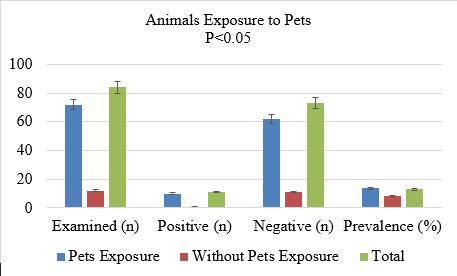THE PREVALENCE, EPIDEMIOLOGY AND RISK FACTORS OF TRYPANOSOMIASIS DISEASE IN BUFFALO
DOI:
https://doi.org/10.71146/kjmr496Keywords:
Trypanosoma Spp., Buffalo, Trypanosomiasis, Epidemiology of Parasitic Diseases, Zoonotic Vector-borne Infections, LivestockAbstract
Trypanosomiasis, a vector-borne parasitic disease caused by Trypanosoma species, poses a major health and economic threat to livestock and human populations in tropical and temperate regions, including Pakistan. This study aimed to determine the prevalence, species identification, clinical signs and associated risk factors of Trypanosoma infection in buffaloes within the Vehari district, a region where disease surveillance is limited. A total of 84 buffaloes, including Nili-Ravi and Kundi breeds, were evaluated using parasitological (microscopic blood smear) and serological (ELISA) diagnostic techniques. The overall prevalence of trypanosomiasis was 13.09%. Among breeds, Kundi buffaloes showed the highest infection rate (16%) compared to Nili-Ravi (11.86%). Gender-based differences were statistically non-significant, though males showed a marginally higher prevalence (13.34%) than females (13.13%). Risk factor analysis revealed that animals housed in herd-based systems (17.94%) and those without vaccination (23.52%) had significantly higher infection rates. Notably, a strong correlation was found between infection and exposure to pets (13.88%) as well as history of exposure to other livestock (17.85%). Age was also a significant determinant, with buffaloes older than five years showing the highest prevalence (15.38%), suggesting age-related susceptibility. Similarly, medicated animals exhibited a higher prevalence (14.28%), possibly due to incomplete or inappropriate treatment protocols. This study underscores the complex interplay of host factors (age, breed), environmental exposures (herd management, contact with other species) and veterinary practices (vaccination, medication) in shaping trypanosomiasis epidemiology. Given its zoonotic potential and impact on productivity, integrated control strategies—incorporating veterinary surveillance, community awareness, vector management and climate-adaptive livestock practices—are essential. The findings emphasize the need for a One Health approach to mitigate the spread of trypanosomiasis and its broader implications for public health, food security and sustainable agriculture in endemic regions.
Downloads

Downloads
Published
Issue
Section
License
Copyright (c) 2025 Muhammad Imran Ul Haq, Asad Rehman, Tooba, Muhammad Imran Malik, Gul e Lala, Abuzar Mehdi Khan (Author)

This work is licensed under a Creative Commons Attribution 4.0 International License.






